2003 VOLVO XC70 height
[x] Cancel search: heightPage 7 of 257
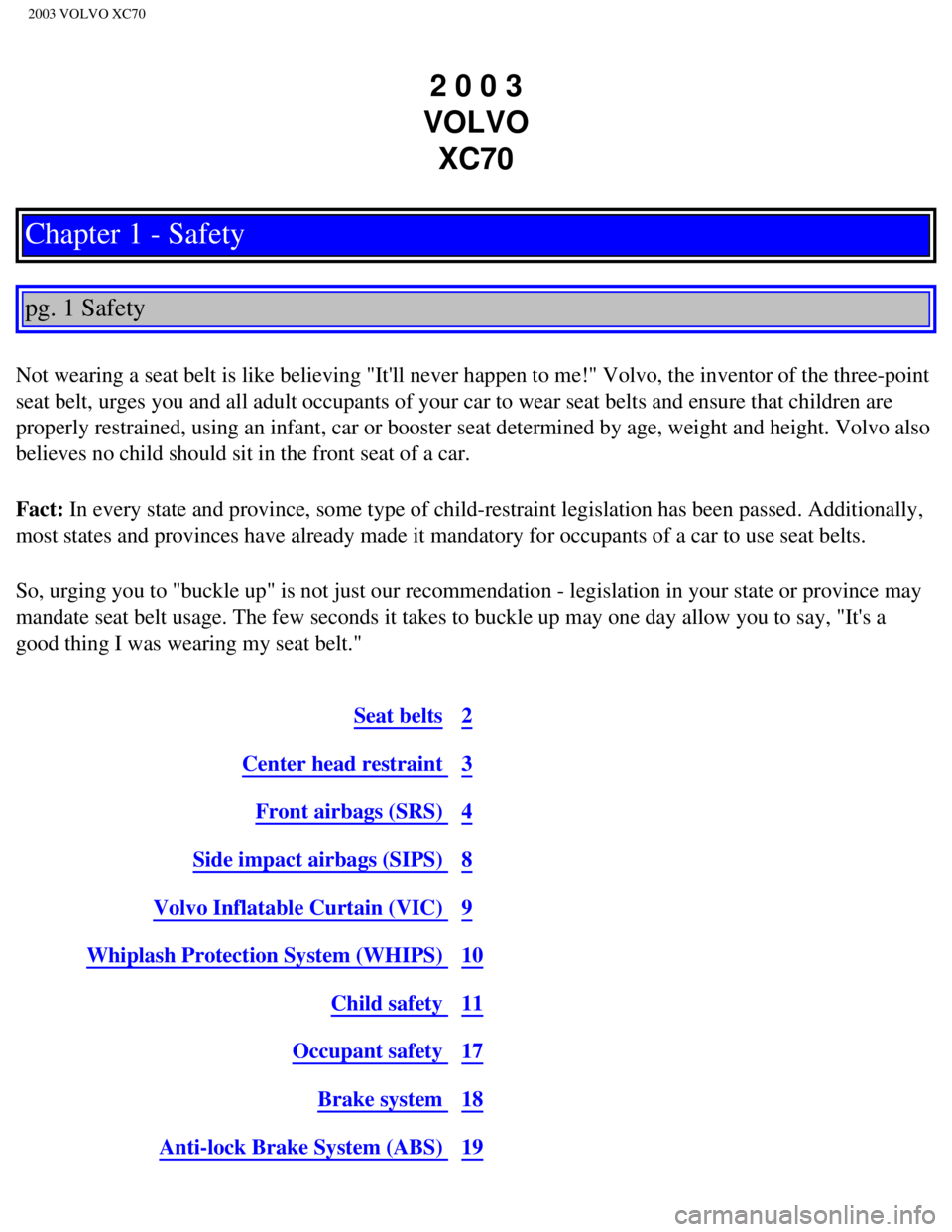
2003 VOLVO XC70
2 0 0 3
VOLVO XC70
Chapter 1 - Safety
pg. 1 Safety
Not wearing a seat belt is like believing "It'll never happen to me!" Vo\
lvo, the inventor of the three-point
seat belt, urges you and all adult occupants of your car to wear seat be\
lts and ensure that children are
properly restrained, using an infant, car or booster seat determined by \
age, weight and height. Volvo also
believes no child should sit in the front seat of a car.
Fact: In every state and province, some type of child-restraint legislation h\
as been passed. Additionally,
most states and provinces have already made it mandatory for occupants o\
f a car to use seat belts.
So, urging you to "buckle up" is not just our recommendation - legislati\
on in your state or province may
mandate seat belt usage. The few seconds it takes to buckle up may one d\
ay allow you to say, "It's a
good thing I was wearing my seat belt."
Seat belts2
Center head restraint 3
Front airbags (SRS) 4
Side impact airbags (SIPS) 8
Volvo Inflatable Curtain (VIC) 9
Whiplash Protection System (WHIPS) 10
Child safety 11
Occupant safety 17
Brake system 18
Anti-lock Brake System (ABS) 19
file:///K|/ownersdocs/2003/2003_XC70/03xc70_01a.htm (1 of 17)12/30/200\
6 4:17:51 PM
Page 10 of 257
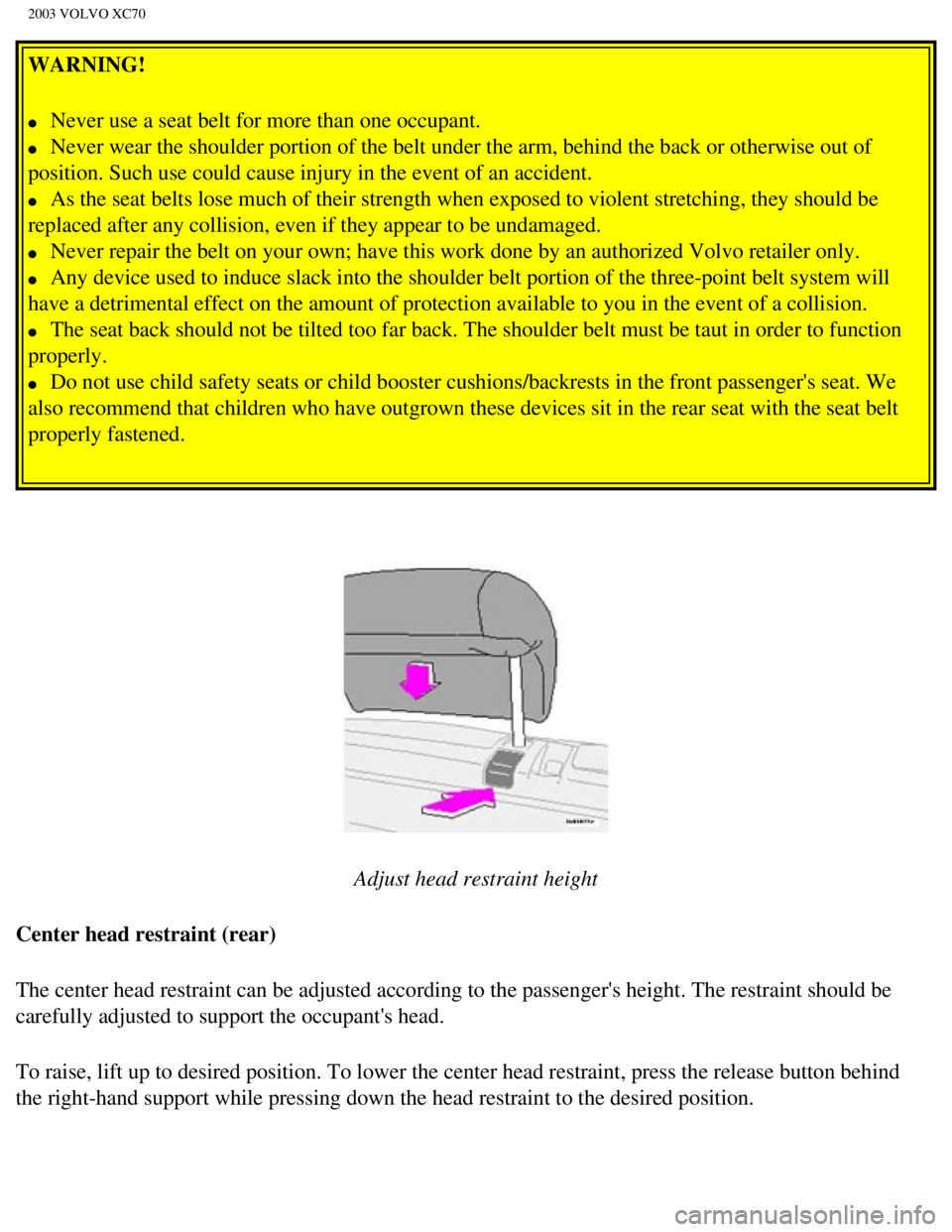
2003 VOLVO XC70
WARNING!
l Never use a seat belt for more than one occupant.
l Never wear the shoulder portion of the belt under the arm, behind the ba\
ck or otherwise out of
position. Such use could cause injury in the event of an accident.
l As the seat belts lose much of their strength when exposed to violent st\
retching, they should be
replaced after any collision, even if they appear to be undamaged.
l Never repair the belt on your own; have this work done by an authorized \
Volvo retailer only.
l Any device used to induce slack into the shoulder belt portion of the th\
ree-point belt system will
have a detrimental effect on the amount of protection available to you i\
n the event of a collision.
l The seat back should not be tilted too far back. The shoulder belt must \
be taut in order to function
properly.
l Do not use child safety seats or child booster cushions/backrests in the\
front passenger's seat. We
also recommend that children who have outgrown these devices sit in the \
rear seat with the seat belt
properly fastened.
Adjust head restraint height
Center head restraint (rear)
The center head restraint can be adjusted according to the passenger's h\
eight. The restraint should be
carefully adjusted to support the occupant's head.
To raise, lift up to desired position. To lower the center head restrain\
t, press the release button behind
the right-hand support while pressing down the head restraint to the des\
ired position.
file:///K|/ownersdocs/2003/2003_XC70/03xc70_01a.htm (4 of 17)12/30/200\
6 4:17:51 PM
Page 15 of 257

2003 VOLVO XC70
WARNING!
Do not use child safety seats or child booster cushions/backrests in the\
front passenger's seat. We also
recommend that occupants under 4 feet 7 inches (140 cm) in height who \
have outgrown these devices
sit in the rear seat with the seat belt fastened.
NOTE: Deployment of SRS components occurs only one time during an accident. In\
a collision where
deployment occurs, the air bags and seat belt tensioners activate. Some \
noise occurs and a small amount
of powder is released. The release of the powder may appear as smoke-lik\
e matter. This is a normal
characteristic and does not indicate fire.
NOTE: Volvo's dual-threshold airbags use special sensors that are integrated with the front seat
buckles. The point at which the air bag deploys is determined by whether\
or not the seat belt is being
used, as well as the severity of the collision. Collisions can occur whe\
re only one of the airbags deploys.
NOTE: Volvo's dual-stage airbags: If the impact is less severe, but severe enough to present a clear
injury risk, the dual-stage airbags are triggered at just 70% of its tot\
al capacity. If the impact is more
severe, the dual-stage airbags are triggered with full capacity.
file:///K|/ownersdocs/2003/2003_XC70/03xc70_01a.htm (9 of 17)12/30/200\
6 4:17:51 PM
Page 24 of 257
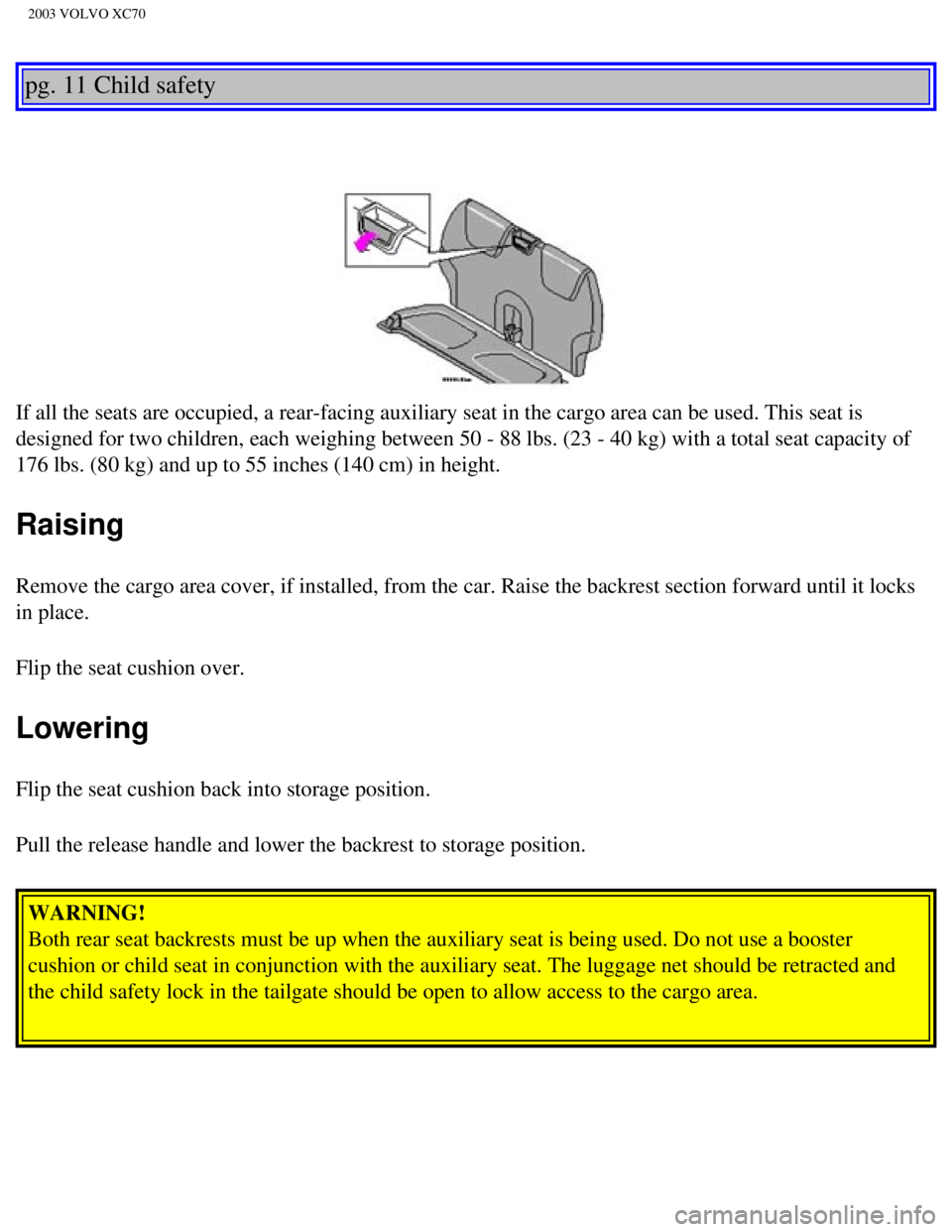
2003 VOLVO XC70
pg. 11 Child safety
If all the seats are occupied, a rear-facing auxiliary seat in the cargo\
area can be used. This seat is
designed for two children, each weighing between 50 - 88 lbs. (23 - 40 \
kg) with a total seat capacity of
176 lbs. (80 kg) and up to 55 inches (140 cm) in height.
Raising
Remove the cargo area cover, if installed, from the car. Raise the backr\
est section forward until it locks
in place.
Flip the seat cushion over.
Lowering
Flip the seat cushion back into storage position.
Pull the release handle and lower the backrest to storage position.
WARNING!
Both rear seat backrests must be up when the auxiliary seat is being use\
d. Do not use a booster
cushion or child seat in conjunction with the auxiliary seat. The luggag\
e net should be retracted and
the child safety lock in the tailgate should be open to allow access to \
the cargo area.
file:///K|/ownersdocs/2003/2003_XC70/03xc70_01b.htm (1 of 14)12/30/200\
6 4:17:52 PM
Page 25 of 257

2003 VOLVO XC70
WARNING!
The exhaust pipe will still be hot when the engine is turned off. Take c\
are that children do not burn
themselves when they get into or out of the car.
pg. 12 Child safety
Integrated booster cushions, outboard positions (optional)
Volvo's own integrated booster cushions have been specially designed to \
help safeguard a child seated in
the rear seat. When using an integrated booster cushion, the child must \
be secured with the vehicle's
three-point seat belt. This child seat is designed for use only by child\
ren who weigh between 33 and 80
lbs (15 and 36 kg) and whose height is between 38 and 54 in. (97 and \
137 cm).
Integrated booster cushion - outboard positions
file:///K|/ownersdocs/2003/2003_XC70/03xc70_01b.htm (2 of 14)12/30/200\
6 4:17:52 PM
Page 30 of 257
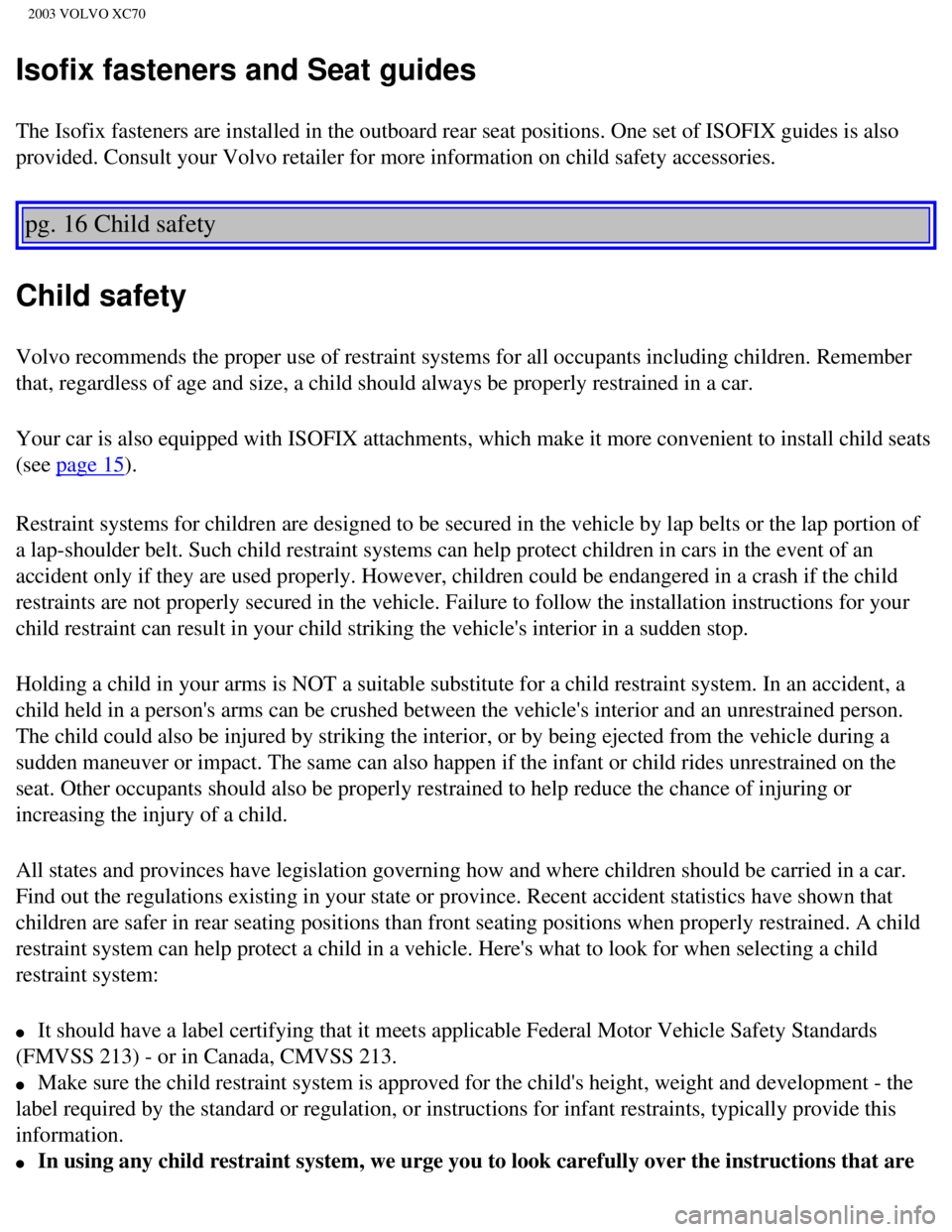
2003 VOLVO XC70
Isofix fasteners and Seat guides
The Isofix fasteners are installed in the outboard rear seat positions. \
One set of ISOFIX guides is also
provided. Consult your Volvo retailer for more information on child safe\
ty accessories.
pg. 16 Child safety
Child safety
Volvo recommends the proper use of restraint systems for all occupants i\
ncluding children. Remember
that, regardless of age and size, a child should always be properly rest\
rained in a car.
Your car is also equipped with ISOFIX attachments, which make it more co\
nvenient to install child seats
(see
page 15).
Restraint systems for children are designed to be secured in the vehicle\
by lap belts or the lap portion of
a lap-shoulder belt. Such child restraint systems can help protect child\
ren in cars in the event of an
accident only if they are used properly. However, children could be enda\
ngered in a crash if the child
restraints are not properly secured in the vehicle. Failure to follow th\
e installation instructions for your
child restraint can result in your child striking the vehicle's interior\
in a sudden stop.
Holding a child in your arms is NOT a suitable substitute for a child re\
straint system. In an accident, a
child held in a person's arms can be crushed between the vehicle's inter\
ior and an unrestrained person.
The child could also be injured by striking the interior, or by being ej\
ected from the vehicle during a
sudden maneuver or impact. The same can also happen if the infant or chi\
ld rides unrestrained on the
seat. Other occupants should also be properly restrained to help reduce \
the chance of injuring or
increasing the injury of a child.
All states and provinces have legislation governing how and where childr\
en should be carried in a car.
Find out the regulations existing in your state or province. Recent acci\
dent statistics have shown that
children are safer in rear seating positions than front seating position\
s when properly restrained. A child
restraint system can help protect a child in a vehicle. Here's what to l\
ook for when selecting a child
restraint system:
l It should have a label certifying that it meets applicable Federal Motor\
Vehicle Safety Standards
(FMVSS 213) - or in Canada, CMVSS 213.
l Make sure the child restraint system is approved for the child's height,\
weight and development - the
label required by the standard or regulation, or instructions for infant\
restraints, typically provide this
information.
l In using any child restraint system, we urge you to look carefully over \
the instructions that are
file:///K|/ownersdocs/2003/2003_XC70/03xc70_01b.htm (7 of 14)12/30/200\
6 4:17:52 PM
Page 31 of 257
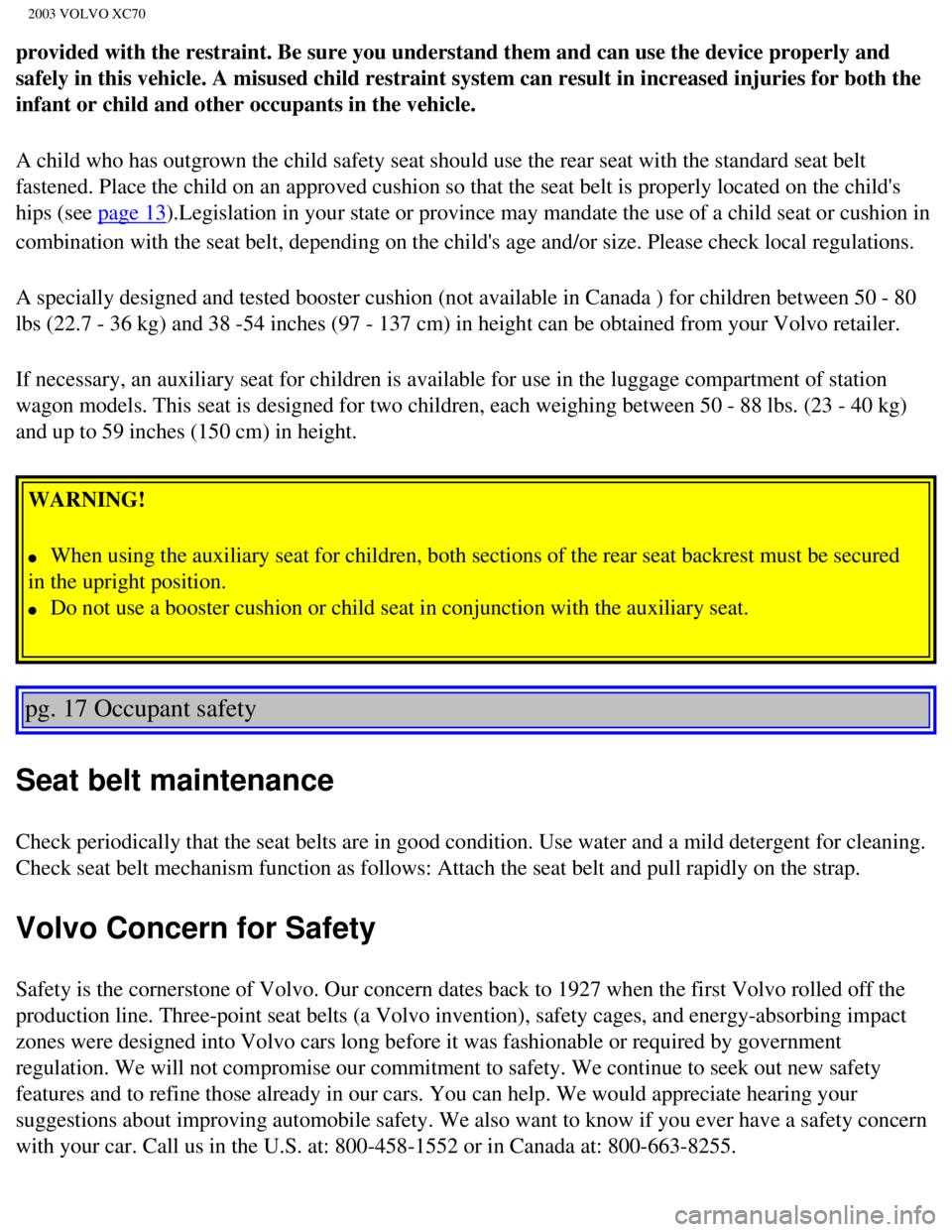
2003 VOLVO XC70
provided with the restraint. Be sure you understand them and can use the\
device properly and
safely in this vehicle. A misused child restraint system can result in i\
ncreased injuries for both the
infant or child and other occupants in the vehicle.
A child who has outgrown the child safety seat should use the rear seat \
with the standard seat belt
fastened. Place the child on an approved cushion so that the seat belt i\
s properly located on the child's
hips (see
page 13).Legislation in your state or province may mandate the use of a child \
seat or cushion in
combination with the seat belt, depending on the child's age and/or size\
. Please check local regulations.
A specially designed and tested booster cushion (not available in Canad\
a ) for children between 50 - 80
lbs (22.7 - 36 kg) and 38 -54 inches (97 - 137 cm) in height can be \
obtained from your Volvo retailer.
If necessary, an auxiliary seat for children is available for use in the\
luggage compartment of station
wagon models. This seat is designed for two children, each weighing betw\
een 50 - 88 lbs. (23 - 40 kg)
and up to 59 inches (150 cm) in height.
WARNING!
l When using the auxiliary seat for children, both sections of the rear se\
at backrest must be secured
in the upright position.
l Do not use a booster cushion or child seat in conjunction with the auxil\
iary seat.
pg. 17 Occupant safety
Seat belt maintenance
Check periodically that the seat belts are in good condition. Use water \
and a mild detergent for cleaning.
Check seat belt mechanism function as follows: Attach the seat belt and \
pull rapidly on the strap.
Volvo Concern for Safety
Safety is the cornerstone of Volvo. Our concern dates back to 1927 when \
the first Volvo rolled off the
production line. Three-point seat belts (a Volvo invention), safety ca\
ges, and energy-absorbing impact
zones were designed into Volvo cars long before it was fashionable or re\
quired by government
regulation. We will not compromise our commitment to safety. We continue\
to seek out new safety
features and to refine those already in our cars. You can help. We would\
appreciate hearing your
suggestions about improving automobile safety. We also want to know if y\
ou ever have a safety concern
with your car. Call us in the U.S. at: 800-458-1552 or in Canada at: 800\
-663-8255.
file:///K|/ownersdocs/2003/2003_XC70/03xc70_01b.htm (8 of 14)12/30/200\
6 4:17:52 PM
Page 54 of 257
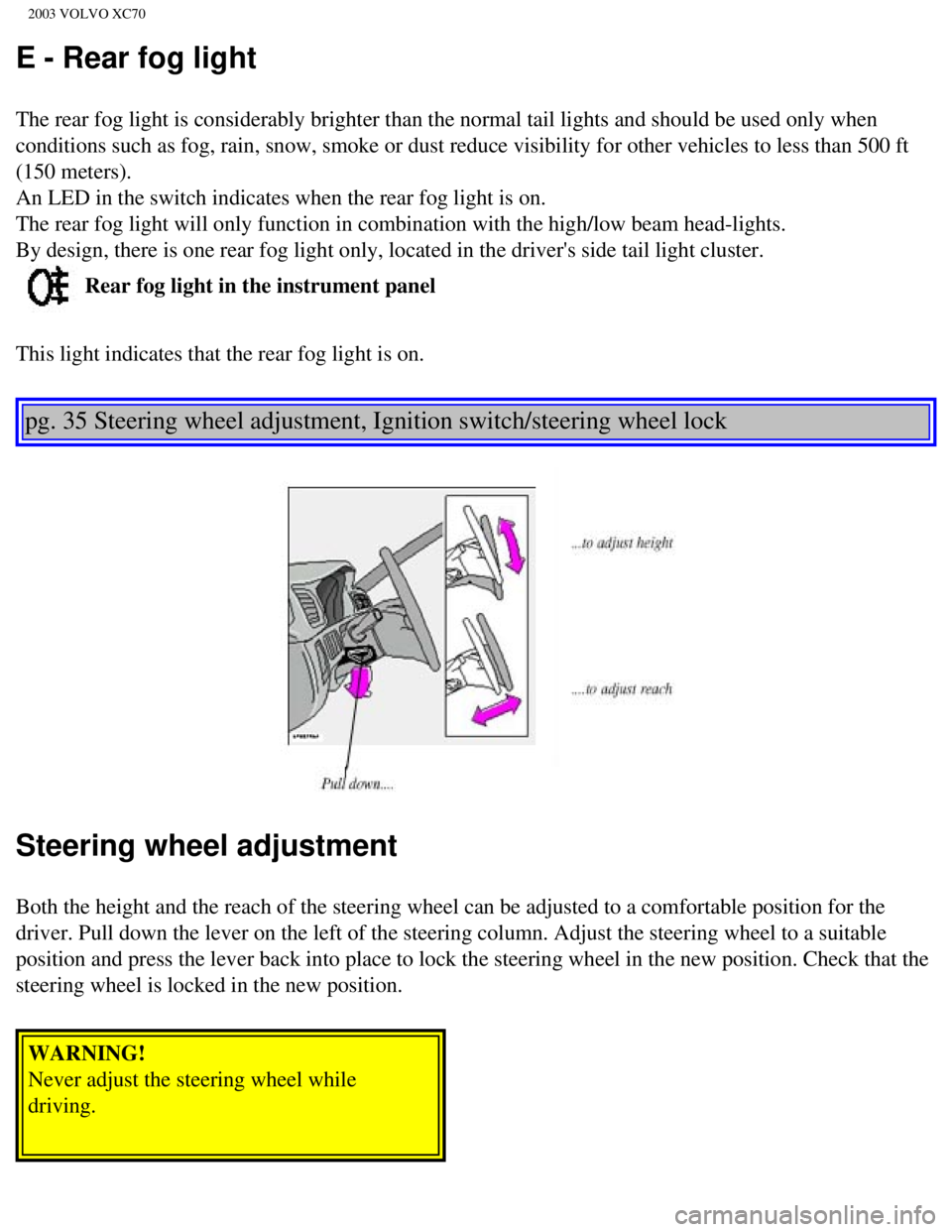
2003 VOLVO XC70
E - Rear fog light
The rear fog light is considerably brighter than the normal tail lights \
and should be used only when
conditions such as fog, rain, snow, smoke or dust reduce visibility for \
other vehicles to less than 500 ft
(150 meters).
An LED in the switch indicates when the rear fog light is on.
The rear fog light will only function in combination with the high/low b\
eam head-lights.
By design, there is one rear fog light only, located in the driver's sid\
e tail light cluster.
Rear fog light in the instrument panel
This light indicates that the rear fog light is on.
pg. 35 Steering wheel adjustment, Ignition switch/steering wheel lock
Steering wheel adjustment
Both the height and the reach of the steering wheel can be adjusted to a\
comfortable position for the
driver. Pull down the lever on the left of the steering column. Adjust t\
he steering wheel to a suitable
position and press the lever back into place to lock the steering wheel \
in the new position. Check that the
steering wheel is locked in the new position.
WARNING!
Never adjust the steering wheel while
driving.
file:///K|/ownersdocs/2003/2003_XC70/03xc70_02b.htm (4 of 18)12/30/200\
6 4:17:54 PM